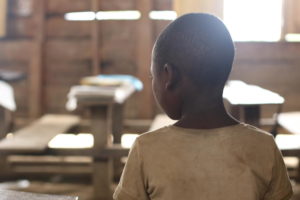We need to end sexual violence against children in conflict

Naomi* feels safe and happy at school, surrounded by friends. What she fears is being alone.
Last year, this eight-year-old girl was abducted while playing with other children. She was left in a field after surviving rape in the conflict-affected North Kivu province in the Democratic Republic of Congo. This traumatic event still makes her fearful.
“I feel great when I find myself with my friends from school, I’m a little sad and sick when I have to go home,” says Naomi. “I dream of becoming a humanitarian. I would like to help children who are victims of violence.”
Naomi is just one of a growing number of young survivors. A groundbreaking report by Save the Children reveals that one in six children living in conflict zones – that’s 72 million – are at risk of sexual violence by armed forces or groups. This can take many horrific forms, including rape, sexual slavery, forced prostitution, forced pregnancy and sexual abuse.
The trauma of sexual violence – often used as a weapon of war to terrorize, control and punish – can leave survivors with long-lasting effects. As well as the physical injuries, especially for children whose bodies are not yet fully developed, the psychological consequences can include Post Traumatic Stress Disorder (PTSD), intense feelings of rage and shame, depression, self-blame and memory loss.
Often the survivors have no way to report the crime and can suffer stigma and rejection from their families and communities, together with the fear of retaliation. These physical and mental wounds can last a lifetime.
While boys are not immune from sexual violence, the overwhelming number of victims are girls, particularly adolescent girls. Data for 2019 shows girls accounted for 98% of verified cases of rape and other forms of sexual violence.
The new report – Weapon of war: Sexual violence against children in conflict – notes: “Worldwide, people of all genders and all ages experience sexual violence, which is fundamentally rooted in unequal power dynamics. For children, their age and gender play a significant role in their vulnerability, placing adolescent girls at particularly high risk of sexual violence in conflict settings.”
Produced in partnership with the Peace Research Institute Oslo, the report is hugely important because it includes the first analysis of the risk of sexual violence against children in conflict areas between 1990 and 2019. The 72 million children at risk are living near armed groups that perpetrate sexual violence against minors. Shockingly, the number of children in danger is 10 times higher than in 1990. The greatest risk is in Colombia, Iraq, Somalia, South Sudan, Syria and Yemen.
More than 20,000 cases of conflict-related sexual violence against children have been verified by the UN since 2006, including 749 in 2019. But that is just the tip of the iceberg. There are many, many more survivors of sexual violence whose terrifying and life-changing ordeals go unrecorded.
When it comes to solutions, we must recognize that girls are affected disproportionately, and that sexual violence is part of a larger epidemic of Gender-based violence. There is an urgent need for the advancement of gender equality and child rights that include an increased focus on girls’ empowerment initiatives. Addressing such gender inequalities targets the root causes of gender-based violence. It is key to reducing barriers to assistance for children and will prevent sexual violence from occurring in the first place.
But the international community – including UN agencies, donors and civil society – needs to do more. The sheer scale of conflicts and humanitarian crises in the world today mean greater financial aid is crucial to respond to the needs of child survivors of sexual violence and to prevent these violations from happening in the first place. Unfortunately, protection focused actions that prevent, mitigate and respond to Gender-based violence and child protection are grossly underfunded in humanitarian settings in comparison to other sectors.
Child rights must be included in all global action against sexual violence in conflict. The international community must uphold current commitments to address all forms of gender based violence. It has to enforce laws and not let the brutal perpetrators get away with their crimes. And there has to be better and more coordinated gathering of data if we are to truly understand how best to combat this horrendous abuse and support survivors to heal and thrive.
Canada’s current strong commitment to gender equality and addressing Gender-based violence in humanitarian settings provides the opportunity for global leadership in addressing sexual violence in conflict, specifically through the work of its Ambassador for Women, Peace and Security and the expected launch of its Feminist Foreign Policy this spring. It is crucial that Canada champions the elevated risks for children in these endeavours.
We owe that much to Naomi and thousands like her. Children who just want to be children, free from the fear of sexual violence.
By: Jenny Becker, Sr. Gender Equality Advisor


